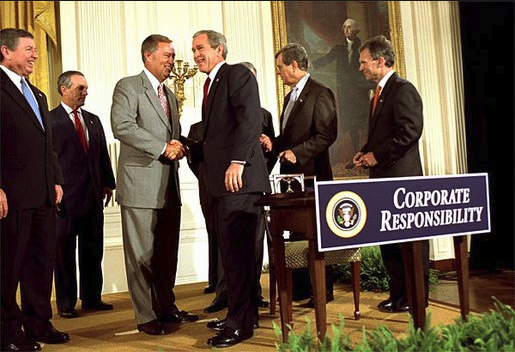The Sarbanes Oxley Act of 2002 is Born (SOX)
During a time when names like Enron, Worldcom, Arthur Andersen, and Tyco were making headlines in the news, Maryland Democratic Senator Paul Sarbanes and Ohio Republican Congressman Michael Garver Oxley were working feverishly to come up the Sarbanes Oxley Act of 2002 (SOX).
Sox was expected to be a cure for the “mysterious illness” that plagued corporate America.
It was a time when ordinary investors felt that the boardrooms of American corporations were shrouded behind a curtain of opacity.



President Bush – After Signing the Sarbanes Oxley Act 2002
It was felt that stewards of corporate America weren’t being honest with their wards (shareholders). Left unchecked, the situation could have potentially seriously undermined the very fabric of American corporations – not just in-country, but globally.
What is The Sarbanes Oxley Act (What is SOX)?
So exactly what is the The Sarbanes Oxley Act of 2002? and what were the key driving factors for the act?
A key milestone for Senator Sarbanes and Senator Oxley was to ensure that there was greater transparency in corporate reporting, and that corporate executives and auditors assumed greater responsibility (and liability) for such reporting.
The fruits of their joint labor, The Sarbanes Oxley Act of 2002 (popularly known as SOX), cleared both houses by an overwhelming majority (House: 423:3, Senate: 99:0).
The SOX Act was signed into law by President George W. Bush on July 30, 2002.
The Sarbanes Oxley Act In Summary
Financial analysts agree that the Sarbanes Oxley Act (also called the Corporate Corruptions Bill), is one of the most significant pieces of legislation to address America’s securities industry in decades.
Not since the passage of the Securities Act of 1933 and creation of the SEC (in the aftermath of the Great Crash of 1929) has such an ambitious piece of legislation been enacted.



Image Source: SOX
In the words of President George W. Bush, as he breathed life into SOX:
“…I sign the most far-reaching reforms of American business practices since the time of Franklin Delano Roosevelt”
Sarbanes Oxley is meant to prevent shareholders (and other parties at interest) from being misled by corporations about their financial status. To achieve its objectives (of reforming US business practices), the Act:
- enhances corporate governance
- strengthens corporate accountability
- introduces more formality in the internal controls of a corporation
- mandates additional checks and balances within organizations (especially with regards to corporate reporting)
- demands greater transparency from senior corporate executives when it comes to key corporate decision-making
- strengthens full-disclosure requirements in financial transactions
- creates the Public Company Accounting Oversight Board (‘PCAOB’ a.k.a. ‘Peek-a-Boo’) tasked with enforcing professional standards, ethics, and competence for the accounting profession
- raises the standards of compliance monitoring on the part of watchdogs like accountants and auditors
- offers protection to whistleblowers who disclose instances of corporate mismanagement, fraud, or wrong-doing
- adds to existing penalties in case corporate wrong-doing is proven
- gives the SEC more resources to oversee/monitor corporate America
Scope of the Sarbanes Oxley Act of 2002
While the Sarbanes Oxley Act is primarily targeted to public companies in the United States, non-US-based entities will also come within its scope if:
• they have securities listed on US exchanges (such as NYSE and Nasdaq) that are regulated by the SEC
• they are required to file annual reporting in the likeness of Form 20-F or Form 40-F
If a non-US entity is specifically exempt from filing SEC statements under Role 12g3-2(b) of the SEC Act 1934, then the provisions of SOX will not apply to them. The distinction of whether specific operations of non-US-based entities (who file with SEC) come under the purview of SOX will be made based on whether there is financial materiality in their operations, or whether there are significant quantitative or qualitative risks that those entities’ operations pose to US financial markets.
All-in-One Change Management Tools
Top Rated Toolkit for Change Managers.
Get Your Change Management Tool Today...
The Sarbanes Oxley Act (SOX) in Titles
SOX is organized into eleven titles, each of them covering specific areas of corporate accountability and responsibility.
These Titles include:
Sarbanes Oxley Act Title I – Public Company Accounting Oversight Board (PCAOB)
This Title creates a new non-governmental entity that will act as an independent body overseeing the audits of public corporations, with the view of protecting the interests of shareholders and the general public. It is also a step towards restoring investor confidence in auditor reporting.
Sarbanes Oxley Act Title II – Auditor Independence
This Title deals with strengthening the independence of companies’ external auditors by addressing key aspects of the auditor’s relationship with the company and its executives. Amongst others, it imposes new restrictions on non-audit services provided to audit clients, and it also proposes new mandates for rotating lead partners in audit firms.
Sarbanes Oxley Act Title III – Corporate Responsibility
Title III primarily governs how public company audit committees review, certify, and sign off on audit reports. It introduces the need for additional diligence on the part of the company’s lawyers, as well as Chief Executive Officers (CEOs) and Chief Financial Officers (CFOs). Certifying officers of public companies must personally attest to the fact that they are satisfied with the organization’s internal controls and that, to the best of their knowledge, “all’s well with the books.”
Sarbanes Oxley Act Title IV – Enhanced Financial Disclosures
Hereto, Corporations enjoyed some leeway in how they reported off-balance sheet arrangements and contractual commitments, as well as in the application of measures related to Generally Acceptable Accounting Principles (GAAP). Title IV introduces rules that more strictly govern these aspects of financial disclosure, including treatment of GAAP and non-GAAP financial reporting.



Sarbanes Oxley Act Title V – Analyst Conflicts of Interest
It is believed that financial analysts had a significant responsibility for the 2008 financial crisis. This Title addresses the conflict of interest between analysts and brokers/dealers for whom they do analysis or prepare reports. For instance, one of the Sections in Title V bars the approval of analyst reports prepared by individuals working with security dealers. A further Section prohibits bankers or brokers/dealers from retaliating against research analysts that publish unfavorable reports about them (bankers, brokers, dealers).
Sarbanes Oxley Act Title VI – Commission Resources and Authority
This Title allocates additional resources for the SEC, as well as expands some of the Commission’s authority viz. violators of its laws. Title VI raises the SEC budget and brings it to around $780M, of which $98M will be used to hire an additional 200 employees specifically dedicated to oversee/monitor auditors. The SEC has also been granted additional powers to investigate and penalize anyone (or any company) that violates security laws.
Sarbanes Oxley Act Title VII – Studies and Reports
Title VII enables regulatory bodies (i.e., the US Comptroller General) the power to conduct studies regarding consolidation in the audit industry and credit rating agencies. It also allows them to study and investigate specific violations/violators of securities laws (e.g., WorldCom, Enron etc.).
Sarbanes Oxley Act Title VIII – Corporate and Criminal Fraud Accountability
This Title makes manipulation of documents, destruction of important documents, or the wilful creation of wrongful documentation a felony. It also makes the act of impeding federal investigations a crime. Punishments for infraction can be significant fines, prison time (up to 20 years), or both. This Title also mandates the retaining of audit records for a period of five years, and provides protection to whistleblowers.









Sarbanes Oxley Act Title IX – White-Collar Crime Penalty Enhancements
This Title places a huge personal burden/liability on CEOs and CFOs, who must now certify that the information in financial reports accurately represents the company’s status. Executives can face jail time (20 years) or penalties (up to $5M), if found negligible. They may also be banned from holding executive office at public companies.
Sarbanes Oxley Act Title X – Corporate Tax Returns
Until SOX came along, CEOs of many public companies had the luxury of saying they don’t “personally look at tax returns because it’s not their job!” This left them somewhat insulated when it came to determining where the buck stopped if it was found that tax returns were misleading or contained incorrect data. Title X closes that loophole, and now makes it the CEO’s duty to sign all Federal income tax returns.
Sarbanes Oxley Act Title XI – Corporate Fraud and Accountability
This Title provides additional (to Title VIII) guidance with respect to rules and punishment regarding fraudulent corporate activities. It authorizes the SEC to freeze remuneration or other forms of payments that may be payable to violators of the rules, pending investigation of the charges.
Highlights of Key SOX Provisions
The enactment of the Sarbanes Oxley Act must not only be looked at in the context of the then prevailing conditions in the US banking and finance industry, but also with regards to how public corporations operated, and were viewed by investors and the general public.
Through the enactment of the Sarbanes Oxley Act, the government at the time introduced key provisions for:
- discouraging conflict of interest amongst various players in the financial industry
- increasing levels of accountability within corporate America
- mandating openness and transparency in corporate reporting
- creating a new oversight and enforcement framework to ensure SOX is properly implemented
Free Wealth & Finance Software - Get Yours Now ►
Conclusion
As with most far-reaching legislation, the Sarbanes Oxley Act too has its supporters and detractors.
Critics of SOX were quick to point out that the costs for small businesses (i.e., auditing and certifying their internal controls annually) could ultimately drive them out of business.
However, an academic study of SOX, conducted almost ten years later, seems to indicate that the Act has, on the whole, proved to be more beneficial than harmful. Authors of the report (Harvard Business School Associate Professor Suraj Srinivasan and Harvard Law School Professor John C. Coates) based their findings on over 120 research papers written on the subject.
They concluded that while the implementation of the Sarbanes Oxley Act could have proved potentially painful for smaller businesses, its ultimate deferral for companies with market capital of less than $75M was a positive development.
Subsequent changes in audit standards are reported to have reduced the cost of audits by as much as 25% for many companies.
According to the report, other criticisms, like the fear of reduced IPOs or the loss of foreign listings on US stock markets as a result of the Sarbanes Oxley Act, were also unsubstantiated.
However, SOX detractors seem to have had the last word in this debate.
They pointed out that despite its enactment in 2002 (most of the Sarbanes Oxley Act’s provisions came into effect as early as 2003), SOX was still unable to prevent the financial crisis of 2008, which was precipitated by the Lehman Brothers Holdings financial scandal!
AdvisoryHQ (AHQ) Disclaimer:
Reasonable efforts have been made by AdvisoryHQ to present accurate information, however all info is presented without warranty. Review AdvisoryHQ’s Terms for details. Also review each firm’s site for the most updated data, rates and info.
Note: Firms and products, including the one(s) reviewed above, may be AdvisoryHQ's affiliates. Click to view AdvisoryHQ's advertiser disclosures.





